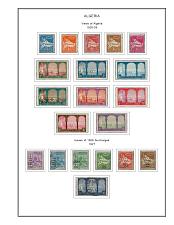33 items found
Philatelists or postage stamp collectors usually learn about their hobby and all the different branches of philately through publications, catalogs, books and other published work. These are guides that describe the various histories of stamps themselves or the eras that they were printed in, even postal stamps from other countries around the world. Other catalogs describe the prices or values of various stamps based on their conditions. Still other publications explain how to grade stamps and their cancellations and so on.
The most common type of publications today are catalogs annual, yearly stamp releases and these are typically organized by country. Each collector has their own style for organizing their collection, such as by the subjects (thematics) on stamps, or the routes of transportation, denominations and more. Publications typically provide a complete list of all stamps in their field of study along with statistics such as time periods, locations and various other attributes - even about plates that stamps were printed on.
Even how you store and handle your stamps properly, is a topic of publication. Serious collectors need proper supplies to maintain their stamps, such as protective envelopes. Albums are a popular way to store and organize their stamps. Magnifiers, or also Loupes, are used to look closely at the stamp for very fine details - and watermark detectors are used as a tool for watermarks on stamps.
One of the very first philately publications known, was created back around 1860 by the young Prince Alfred of the British Royal Family. He was very interested in stamp collecting. When this fact became public, people began creating the first albums for collectible British stamps, which featured an outline for all the variations of the stamps after the postmark was implemented. As time went on, there was just too many variations and selections of stamps being printed and this became impractical. So they had to start dividing up the publication into multiple ones based on countries of origins.
The British Royal Family was full of serious stamp collectors. In 1904, Prince George paid £1,450 to purchase a 2-cent stamp (unused) from Mauritius. This was quite a fortune and the most ever paid for a single stamp at this time. This was also enough to gather media attention, which really helped publicize the hobby, making it popular and also very lucrative in the rare-stamp market.

































